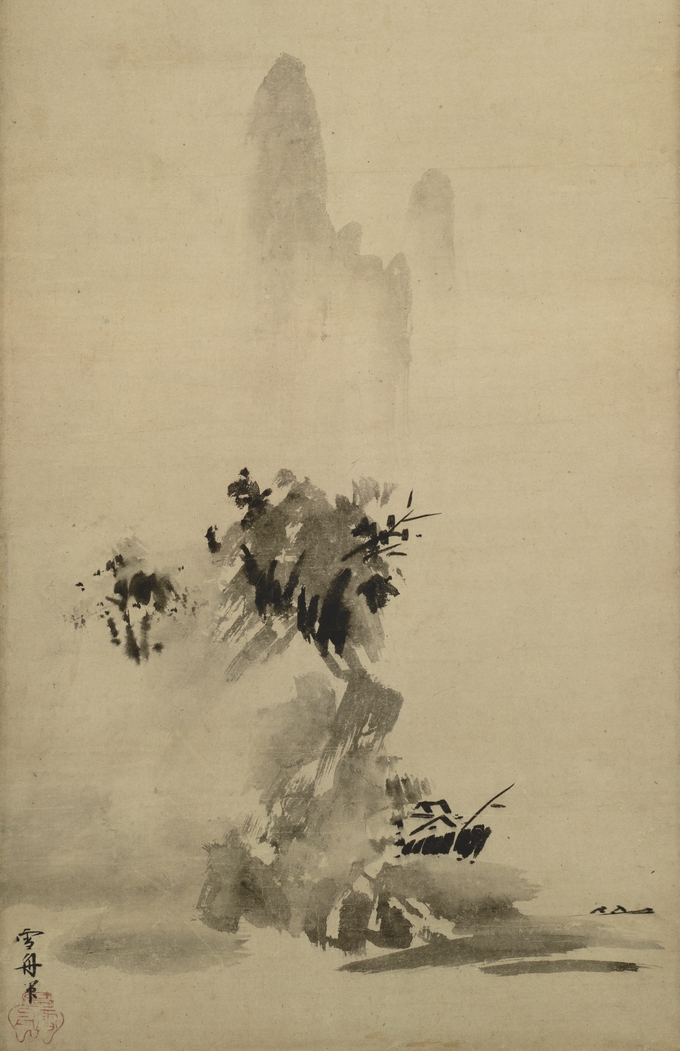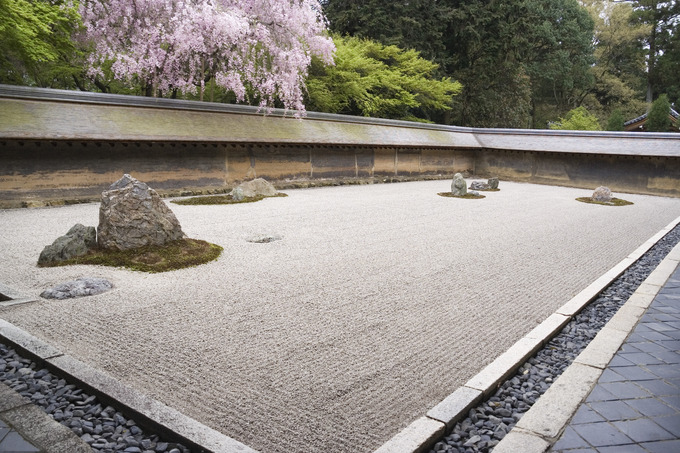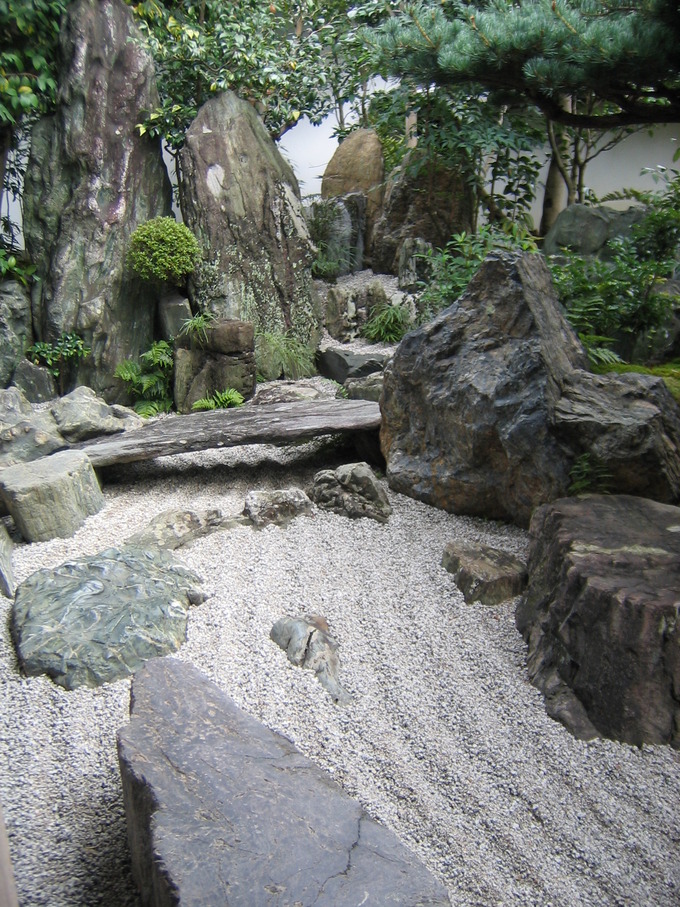24.1: The Muromachi Period
- Page ID
- 53099
Zen Ink Painting
During the Muromachi period (1333–1578), Zen Buddhism played an influential role in the development of Zen ink painting in Japan.
Learning Objectives
Distinguish the techniques of the Yamato-e, Sumi-e, Sansuiga, and Shigajiku styles of Japanese Zen Ink painting
Key Takeaways
Key Points
- The development of the great Zen monasteries in Kamakura and Kyoto had a great influence on the visual arts of the Muromachi period.
- The foremost painter of the new Sumi-e style was Sesshū Tōyō (1420–1506), whose most dramatic works were completed in the Chinese splashed-ink (Haboku) style.
- The Sumi-e style was highly influenced by calligraphy, employing the same tools and style as well as its Zen philosophy.
- By the end of the 14th century, monochrome landscape paintings (sansuiga) had found patronage by the ruling Ashikaga family and were the preferred genre among Zen painters, gradually evolving from its Chinese roots to a more Japanese style.
- Another style that developed during the Muromachi period was Shigajiku (詩), or paintings accompanied by poetry; this style had its roots in China, where painting and poetry were seen as inherently connected.
Key Terms
- calligraphy: The art of writing letters and words with decorative strokes.
- Koan: A story, dialogue, question, or statement, which is used in Zen practice to provoke the “great doubt” and test a student’s progress.
- shogunate: A hereditary military dictator in Japan during the period from 1185 to 1868 (with exceptions).
Background: The Muromachi Period
During the Muromachi period (1333–1578), also known as the Ashikaga period, a profound change took place in Japanese culture. The Ashikaga clan took control of the shogunate and moved its headquarters back to Kyoto, to the Muromachi district of the city. With the return of government to the capital, the popularizing trends of the Kamakura period came to an end, and cultural expression took on a more aristocratic, elitist character. During the Muromachi Period, Zen Buddhism rose to prominence—especially among the elite Samurai class, who embraced the Zen values of personal discipline, concentration, and self-development.
Impact on the Arts
The establishment of the great Zen monasteries in Kamakura and Kyoto had a major impact on the visual arts. Because of secular ventures and trading missions to China organized by Zen temples, many Chinese paintings and objects of art were imported into Japan, profoundly influencing Japanese artists working for Zen temples and the shogunate. These imports not only changed the subject matter of painting, but they also modified the use of color; the bright colors of Yamato-e yielded to the monochromes of painting in the Chinese manner of Sui-boku-ga (水) or Sumi-e (墨). This style mainly used only black ink—the same as used in East Asian calligraphy.
Sesshū Tōyō and the Haboku Style
The foremost painter of the new Sumi-e style was Sesshū Tōyō (1420–1506), a Rinzai priest who traveled to China in 1468–69 and studied contemporary Ming painting. Some of his most dramatic works are in the Chinese splashed-ink (Haboku) style. Upon returning to Japan, Sesshū built himself a studio and established a large following; these painters are now referred to as the Unkoku-rin school or School of Sesshū.
To make one of the calligraphic and highly stylized Haboku paintings, the painter would visualize the image and then make swift broad strokes onto the paper, resulting in a splashed and abstract composition. This was all done with meditative concentration. This impressionistic style of painting was supposed to capture the true nature of the subject. The Sumi-e style was highly influenced by calligraphy, using the same tools and style as well as its Zen philosophy. To paint in this style, the practitioner had to clear his mind and apply the brushstrokes without too much thinking, termed mushin (無) by the Japanese philosopher Nishida Kitaro. The concept of mushin is central to many Japanese arts, including the art of the sword, archery, and the tea ceremony.

Haboku-Sansui, Sesshū, 1495, ink on silk: Splashed-ink style landscape by Sesshū Tōyō (1420–1506)
Sansuiga
By the end of the 14th century, monochrome landscape paintings (sansuiga) had found patronage by the ruling Ashikaga family and became the preferred genre among Zen painters, gradually evolving from their Chinese roots to a more Japanese style. An important landscape painter during this period was Tenshō Shūbun, a monk at the Kyoto temple of Shōkoku-ji who traveled to Korea and studied under Chinese painters. He returned to Japan in 1404 and settled in Kyoto, then the capital city. He became director of the court painting bureau that had been established by Ashikaga shoguns, who were influential art patrons. Shūbun’s best known landscape painting, designated as a National Treasure in Japan, is Reading in a Bamboo Grove, now kept in the Tokyo National Museum.

Detail of Reading in a Bamboo Grove, 1446, Shūbun: Tenshō Shūbun’s (1414–1463) best known landscape painting.
Shigajiku
Another style that developed in the Muromachi period is Shigajiku (詩). This is usually a painting accompanied by poetry and has its roots in China, where painting and poetry were seen as inherently connected. This style grew out of literary circles; an artist would usually be given a subject to paint, and the poets would compose accompanying verses to be written above the work.
A famous example is the scroll Catching a Catfish with a Gourd (Hyōnen-zu 瓢), located at Taizō-in, Myōshin-ji, Kyoto. Created by the priest-painter Josetsu (c. 1386–1428), it includes 31 verses of many Zen priests inscribed above the painting. In the foreground of the painting, a man is depicted on the bank of a stream holding a small gourd and looking at a large slithery catfish. Mist fills the middle ground, and the background mountains appear to be far in the distance. The painting was commissioned by the 4th Shogun of the Muromachi Period, Ashikaga Yoshimochi (1386–1428), and was based on the nonsensical riddle: “How do you catch a catfish with a gourd?” The painting and accompanying poems capture both the playfulness and the perplexing nature of Zen buddhist Koans, which were supposed to aid the Zen practitioner in their meditation.
In the late Muromachi period, ink painting had migrated out of the Zen monasteries into the art world in general. Artists from the Kano School and the Ami School adopted the style and themes but introduced a more plastic and decorative effect that would continue into modern times.
Zen Dry Rock Gardens
Zen dry rock gardens were created at temples of Zen Buddhism during the Muromachi Period to imitate the intimate essence of nature.
Learning Objectives
Describe the features of the Zen dry rock gardens of the Muromachi Period
Key Takeaways
Key Points
- The Muromachi Period in Japan was characterized by political rivalaries that frequently led to wars, but also by an extraordinary flourishing of Japanese culture. It saw the beginning of Noh theater, the Japanese tea ceremony, the shoin style of Japanese architecture, and the zen garden.
- In Kyoto in the 14th and 15th century, a new kind of garden designed to stimulate meditation began to appear at the important zen temples.
- These new zen dry rock gardens were usually relatively small, surrounded by a wall, and meant to be seen while seated from a single viewpoint outside the garden.
- The invention of the zen garden was closely connected with developments in Japanese ink landscape paintings. Japanese painters such as Sesshū Tōyō (1420–1506) and Soami (1472–1525) greatly simplified their views of nature, showing only the most essential aspects of nature.
- The most famous of all zen gardens in Kyoto is Ryōan-ji, built in the late 15th century when, for the first time, the zen garden became purely abstract.
Key Terms
- Noh theater: A major form of classical Japanese musical drama that has been performed since the 14th century; many characters are masked, with men playing both male and female roles.
- shoin: A type of audience hall in Japanese architecture that was developed during the Muromachi period; the term originally meant a study and a place for lectures on the sūtra within a temple, but later it came to mean just a drawing room or study.
Background: The Muromachi Period
The Muromachi Period in Japan, which took place at roughly the same time as the Renaissance in Europe, was characterized by political rivalries that frequently led to wars. However, it was also characterized by an extraordinary flourishing of Japanese culture. It saw the beginning of Noh theater, the Japanese tea ceremony, the shoin style of Japanese architecture, and the zen garden.
A New Kind of Garden
Zen Buddhism was introduced into Japan at the end of the 12th century. It quickly achieved a wide following, particularly among the Samurai class and war lords, who admired its doctrine of self-discipline. The gardens of the early zen temples in Japan resembled Chinese gardens at the time, with lakes and islands. However, in Kyoto in the 14th and 15th century, a new kind of garden appeared at the important zen temples. These zen gardens were designed to stimulate meditation. “Nature, if you made it expressive by reducing it to its abstract forms, could transmit the most profound thoughts by its simple presence,” Michel Baridon, a well-known researcher, wrote. “The compositions of stone, already common China, became in Japan, veritable petrified landscapes, which seemed suspended in time, as in a certain moment of Noh theater, which dates to the same period.”
Saihō-ji
The first garden to begin the transition to this new style is considered by many experts to be Saihō-ji, The Temple of the Perfumes of the West—popularly known as Koke-dera, the Moss Garden—in the western part of Kyoto. The Buddhist monk and zen master Musō Kokushi transformed a Buddhist temple into a zen monastery in 1334 and built the gardens. The lower garden of Saihō-ji is in the traditional Heian Period style: a pond with several rock compositions representing islands. The upper garden is a dry rock garden featuring three rock “islands.” The first, called Kameshima (the island of the turtle), resembles a turtle swimming in a “lake” of moss. The second, Zazen-seki, is a flat meditation rock that is believed to radiate calm and silence. The third island is the kare-taki, a dry “waterfall” composed of a stairway of flat granite rocks. The moss that now surrounds the rocks and represents water was not part of the original garden plan; it grew several centuries later when the garden was left untended. However, it is now the most famous feature of the garden.

The moss gardens of Saihō-ji: Golden Pond in the center of the moss garden.
Tenryū-ji
Muso Kokushi built another temple garden at Tenryū-ji, known as the Temple of the Celestial Dragon. This garden appears to have been strongly influenced by Chinese landscape paintings of the Song Dynasty, which feature mountains rising in the mist and suggest great depth and height. The garden at Tenryū-ji has a real pond with water and a dry waterfall of rocks, appearing similar to a Chinese landscape. Saihō-ji and Tenryū-ji show the transition from the Heian style garden toward a more abstract and stylized view of nature.
Ginkaku-ji
The gardens of Ginkaku-ji, also known as the Silver Pavilion, are also attributed to Muso Kokushi. This temple garden includes a traditional pond garden, but it had a new feature for a Japanese garden: an area of raked white gravel with a perfectly shaped mountain of white gravel, resembling Mount Fuji, in the center. The scene is called ginshanada, or “sand of silver and open sea.” This garden feature became known as kogetsudai, or “small mountain facing the moon.” After this garden was built, similar small Mount Fujis made of sand or earth covered with grass appeared in Japanese gardens for centuries afterwards.

Silver Pavilion at Ginkaku-ji, a Buddhist temple in Kyoto, Japan: At the gardens at Ginkaku-ji, commonly known as the Silver Pavilion, the viewer can see the perfectly shaped mountain of white gravel, resembling Mount Fuji, in the center.
Ryōan-ji
The most famous of all zen gardens in Kyoto is Ryōan-ji, built in the late 15th century where, for the first time, the zen garden became purely abstract. The garden is a rectangle of 340 square meters. Placed within it are 15 stones of different sizes, carefully composed in five groups: one group of five stones, two groups of three, and two groups of two stones. The stones are surrounded by white gravel, which is carefully raked every day by the monks. The only vegetation in the garden is some moss around the stones. The garden is meant to be viewed from a seated position on the veranda of the hōjō, the residence of the abbot of the monastery.

Ryōan-ji (late 15th century) in Kyoto, Japan, a famous example of a zen garden: The most famous of all zen gardens in Kyoto is Ryōan-ji, built in the late 15th century where for the first time the zen garden became purely abstract.
Daisen-in
The garden at Daisen-in (1509–1513) took a more literary approach than Ryōan-ji. A “river” of white gravel represents a metaphorical journey through life—beginning with a dry waterfall in the mountains, passing through rapids and rocks, and ending in a tranquil sea of white gravel with two gravel mountains.

A mountain, waterfall, and gravel “river” at Daisen-in (1509–1513): The garden at Daisen-in took a more literary approach than Ryōan-ji, with its “river” of white gravel representing a metaphorical journey through life.
- Curation and Revision. Provided by: Boundless.com. License: CC BY-SA: Attribution-ShareAlike
- Buddhist art in Japan. Provided by: Wikipedia. Located at: en.Wikipedia.org/wiki/Buddhist_art_in_Japan. License: CC BY-SA: Attribution-ShareAlike
- calligraphy. Provided by: Wiktionary. Located at: en.wiktionary.org/wiki/calligraphy. License: CC BY-SA: Attribution-ShareAlike
- Koan. Provided by: Wikipedia. Located at: en.Wikipedia.org/wiki/Koan. License: CC BY-SA: Attribution-ShareAlike
- Shubun - Reading in a Bamboo Grove detail. Provided by: Wikipedia. Located at: en.Wikipedia.org/wiki/File:Shubun_-_Reading_in_a_Bamboo_Grove_detail.jpg. License: Public Domain: No Known Copyright
- Sesshu - Haboku-Sansui. Provided by: Wikipedia. Located at: en.Wikipedia.org/wiki/File:Sesshu_-_Haboku-Sansui.jpg. License: Public Domain: No Known Copyright
- Japanese rock garden. Provided by: Wikipedia. Located at: en.Wikipedia.org/wiki/Japanese_rock_garden. License: CC BY-SA: Attribution-ShareAlike
- shoin. Provided by: Wikipedia. Located at: en.Wikipedia.org/wiki/shoin. License: CC BY-SA: Attribution-ShareAlike
- Noh theater. Provided by: Wikipedia. Located at: en.Wikipedia.org/wiki/Noh%20theater. License: CC BY-SA: Attribution-ShareAlike
- Shubun - Reading in a Bamboo Grove detail. Provided by: Wikipedia. Located at: en.Wikipedia.org/wiki/File:Shubun_-_Reading_in_a_Bamboo_Grove_detail.jpg. License: Public Domain: No Known Copyright
- Sesshu - Haboku-Sansui. Provided by: Wikipedia. Located at: en.Wikipedia.org/wiki/File:Sesshu_-_Haboku-Sansui.jpg. License: Public Domain: No Known Copyright
- Daisen-in2. Provided by: Wikipedia. Located at: en.Wikipedia.org/wiki/File:Daisen-in2.jpg. License: Public Domain: No Known Copyright
- 1024px-Ginkakuji_Temple_mars_2009_053.jpg. Provided by: Wikipedia. Located at: en.Wikipedia.org/wiki/Ginkaku-ji#/media/File:Ginkakuji_Temple_mars_2009_053.jpg. License: CC BY-SA: Attribution-ShareAlike
- 1024px-Saihouji-kokedera02.jpg. Provided by: Wikipedia. Located at: en.Wikipedia.org/wiki/Saih%C5%8D-ji_(Kyoto)#/media/File:Saihouji-kokedera02.jpg. License: CC BY-SA: Attribution-ShareAlike
- Kyoto-Ryoan-Ji MG 4512. Provided by: Wikipedia. Located at: en.Wikipedia.org/wiki/File:Kyoto-Ryoan-Ji_MG_4512.jpg. License: CC BY-SA: Attribution-ShareAlike

